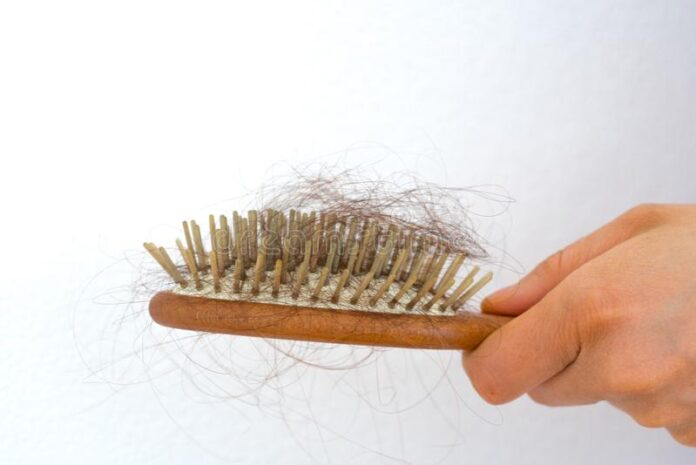Contrary to popular belief, hair loss is not simply a male problem. Female hair loss is real, and it can be incredibly damaging to a woman’s self-esteem. There are several different forms of hair loss that can affect women that stem from a number of causes. Luckily, there are also a lot of treatments that you can try to remedy the hair loss, so let’s get into it.
Types of Hair Loss
Hair loss in women can present in a few different ways depending on what form of hair loss you are experiencing. Firstly, there is androgenetic alopecia which, as the name suggests, tends to happen for genetic reasons. Some women have a history of female pattern baldness in their families, and in fact, androgenetic alopecia is the leading cause of hair loss in women.
The next form of hair loss in women is alopecia areata which is actually an autoimmune condition. It causes the hair to fall out in patches. The condition may progress further, and you might end up losing all of your hair, but this is rare.
There is also cicatricial alopecia. If you have this condition, then you might not be able to treat or reverse the hair loss. This is because the immune system begins to attack the hair follicles, which can replace the follicles with hair tissue stunting the possibility of new growth.
Traumatic alopecia occurs when the hair is damaged by trauma, and it begins to shed or break off in excess. Styling products that produce a lot of heat or rely on harsh chemicals can cause damage to the hair. The hair is stripped of its natural oils, making it more brittle and prone to breakage.
The final form of hair loss is telogen effluvium; this is also a form of trauma-related hair loss. Except in this instance, the body is affected by a traumatic experience. The stress disrupts the hair cycle, which can lead to thinning hair and hair loss. However, it is usually only temporary.
Causes of Hair Loss in Women
When it comes to hair loss in women, there are several causes. First, your lifestyle choices can contribute to your hair loss. For example, smoking has been linked to hair loss. While quitting smoking completely is often difficult and therefore trying to quit cold turkey is simply setting yourself up for failure. Other methods can satisfy your cravings without worsening your hair loss; you could try vaping to help to restore your hair growth.
Hair loss can also be caused by a number of medical conditions like hypothyroidism, hypopituitarism, Hashimoto’s disease, Hodgkin’s disease, Addison’s disease, Scerloroma, Lupus, Lichen Planus, Tinea Capitis, Polycystic Ovary Syndrome and Celiac Disease. These medical conditions have more than simply hair loss as a symptom or a side effect, so if you are concerned about any of them, you should do your research to see if you have any of the other symptoms before consulting a medical professional.
The next thing that can cause hair loss in women is a hormonal imbalance. Hormones play an important role in the hair cycle. Fluctuating levels of hormones can disrupt hair growth. For example, high levels of testosterone can lead to hair loss. A reduction in oestrogen and progesterone can also be a contributor to hair loss, and this commonly occurs after giving birth or as a result of menopause. If the androgen levels climb too high, your hair may begin to thin.
Another contributing factor to hair loss is stress. Stress can trigger a number of reactions within the body. It can slow down the processes within the body. It can disrupt the production of new hair and the efficacy of your hair follicles. Stress tends to be cyclical in that the stress causes hair loss which then causes more stress and on and on. There are ways to reduce your stress, but it might be worth consulting a doctor if you suffer from chronic stress.
Finally, vitamin deficiency has also been linked to hair loss. Specifically, a lack of vitamin D has been linked to alopecia areata in both genders. Luckily, if your hair loss is down to a vitamin deficiency, it is easy to remedy; all you need to do is consume more foods which are rich in vitamins and minerals.
Treatments to Consider
Hair loss can be hard to cope with, luckily there are a number of treatments to consider. The treatment you choose will obviously depend on the cause of your hair loss, but you do have options. Firstly, you could try minoxidil. Minoxidil is a topical treatment which is applied directly to the scalp. It is meant to prompt hair growth, but it is not an overnight treatment; it can take months to see any results, and if you stop using it, then the issues may recur. Minoxidil doesn’t have to be prescribed; it is often available over the counter.
Topical tretinoin is often prescribed to be used in conjunction with minoxidil. However, it should only be used as advised by your doctor because if used incorrectly, it may actually worsen your hair loss. When using topical tretinoin, it is important to organise regular follow-ups with your doctor to ensure that everything is progressing as it should. Anthralin is typically used to treat alopecia areata. It is another form of topical treatment. It is applied to the scalp daily. It is used as a hair mask of sorts which means that it does need rinsing off afterwards with cold water and soap.
If your hair loss is the result of a hormone imbalance or if you have androgenic alopecia, then you should consult your doctor, who will likely suggest hormone replacement therapy. This treatment focuses on ensuring that your body has the right hormone levels. For example, you might be given oestrogen supplements or testosterone suppressants, depending on what your issue is. In ensuring that your hormone levels are more stable, you are likely to find that your hair is growing back.
Your doctor might recommend corticosteroids to deal with your hair loss. When it comes to corticosteroids, you might be prescribed them in one of two delivery methods. Firstly, you can ingest them orally if your doctor thinks that would be best for you. They can also be prescribed as injections directly into the affected areas. This method can yield results in a few weeks. If your doctor has recommended injections, then you will likely need to get them every four to six weeks until your doctor is happy with the results.
Finally, if you have exhausted other methods without seeing any improvements, you might want to consider going down the surgery route. It is obviously the most invasive option, but it can also yield the best results. Hair transplants and restoration surgeries are for everyone. be sure to talk to your doctor before committing to something like this.
The Takeaway
Genetic factors, high-stress levels or a change in hormone levels can all contribute to female hair loss. Hair loss can have a significant effect on your mental health regardless of gender but perhaps even more so for women because hair is often closely linked to femininity. Luckily, there are a number of treatment options that you can explore. Discuss your options with your doctor to work out which course of action would be better for you.
Further helpful information can be found at
https://xrsbeautyhair.com/blogs/hair-blog/hair-loss-in-women
Help keep news FREE for our readers
Supporting your local community newspaper/online news outlet is crucial now more than ever. If you believe in independent journalism, then consider making a valuable contribution by making a one-time or monthly donation. We operate in rural areas where providing unbiased news can be challenging. Read More About Supporting The West Wales Chronicle


























